Regional Security Assessment of Integrated Energy Systems with Renewables in China: A Grid-Connected Perspective
Abstract
1. Introduction
2. Methodology
2.1. Moran’s I Test Models
2.2. Natural Disaster Risk Assessment Method
3. Security Assessment Dimensions and Metrics of Integrated Energy Systems
3.1. Integrated Energy System Security Assessment Framework
3.1.1. Resources
3.1.2. Generation
3.1.3. Transmission
3.1.4. Marketing
3.1.5. Consumption
3.2. Data Collection and Processing
4. Results and Discussion
4.1. Convergence Characteristics of Interprovincial Grid Connection
4.2. Weight of Grid-Connected Integrated Energy System Security Metrics
4.3. Energy Security Performance of Integrated Energy System
5. Conclusions
Author Contributions
Funding
Conflicts of Interest
References
- Ang, B.W.; Choong, W.L.; Ng, T.S. Energy security: Definitions, dimensions and indexes. Renew. Sustain. Energy Rev. 2015, 42, 1077–1093. [Google Scholar] [CrossRef]
- Ang, B.W.; Choong, W.L.; Ng, T.S. A framework for evaluating Singapore’s energy security. Appl. Energy 2015, 148, 314–325. [Google Scholar] [CrossRef]
- Winzer, C. Conceptualizing energy security. Energy Policy 2012, 46, 36–48. [Google Scholar] [CrossRef]
- Johansson, B. A broadened typology on energy and security. Energy 2013, 53, 199–205. [Google Scholar] [CrossRef]
- Von Hippel, D.; Suzuki, T.; Williams, J.H.; Savage, T.; Hayes, P. Energy security and sustainability in Northeast Asia. Energy Policy 2011, 39, 6719–6730. [Google Scholar] [CrossRef]
- Below, A. Obstacles in energy security: An analysis of congressional and presidential framing in the United States. Energy Policy 2013, 62, 860–868. [Google Scholar] [CrossRef]
- Yao, L.; Chang, Y. Energy security in China: A quantitative analysis and policy implications. Energy Policy 2014, 67, 595–604. [Google Scholar] [CrossRef]
- Ren, J.; Sovacool, B.K. Quantifying, measuring, and strategizing energy security: Determining the most meaningful dimensions and metrics. Energy 2014, 76, 838–849. [Google Scholar] [CrossRef]
- Zeng, S.; Streimikiene, D.; Baležentis, T. Review of and comparative assessment of energy security in Baltic States. Renew. Sustain. Energy Rev. 2017, 76, 185–192. [Google Scholar] [CrossRef]
- García-Gusano, D.; Iribarren, D.; Garraín, D. Prospective analysis of energy security: A practical life-cycle approach focused on renewable power generation and oriented towards policy-makers. Appl. Energy 2017, 190, 891–901. [Google Scholar] [CrossRef]
- Hughes, L. A generic framework for the description and analysis of energy security in an energy system. Energy Policy 2012, 42, 221–231. [Google Scholar] [CrossRef]
- Augutis, J.; Krikštolaitis, R.; Martišauskas, L.; Pečiulytė, S.; Žutautaitė, I. Integrated energy security assessment. Energy 2017, 138, 890–901. [Google Scholar] [CrossRef]
- Chung, W.; Kim, S.; Moon, K.; Lim, C.; Yun, S. A conceptual framework for energy security evaluation of power sources in South Korea. Energy 2017, 137, 1066–1074. [Google Scholar] [CrossRef]
- Pambour, K.A.; Cakir Erdener, B.; Bolado-Lavin, R.; Dijkema, G.P.J. SAInt—A novel quasi-dynamic model for assessing security of supply in coupled gas and electricity transmission networks. Appl. Energy 2017, 203, 829–857. [Google Scholar] [CrossRef]
- Ranjan, A.; Hughes, L. Energy security and the diversity of energy flows in an energy system. Energy 2014, 73, 137–144. [Google Scholar] [CrossRef]
- Chalvatzis, K.J.; Ioannidis, A. Energy supply security in the EU: Benchmarking diversity and dependence of primary energy. Appl. Energy 2017, 207, 465–476. [Google Scholar] [CrossRef]
- Balta-Ozkan, N.; le Gallo, J. Spatial variation in energy attitudes and perceptions: Evidence from Europe. Renew. Sustain. Energy Rev. 2018, 81, 2160–2180. [Google Scholar] [CrossRef]
- Sovacool, B.K.; Mukherjee, I.; Drupady, I.M.; D’Agostino, A.L. Evaluating energy security performance from 1990 to 2010 for eighteen countries. Energy 2011, 36, 5846–5853. [Google Scholar] [CrossRef]
- Viholainen, J.; Luoranen, M.; Väisänen, S.; Niskanen, A.; Horttanainen, M.; Soukka, R. Regional level approach for increasing energy efficiency. Appl. Energy 2016, 163, 295–303. [Google Scholar] [CrossRef]
- Zhang, L.; Yu, J.; Sovacool, B.K.; Ren, J. Measuring energy security performance within China: Toward an inter-provincial prospective. Energy 2017, 125, 825–836. [Google Scholar] [CrossRef]
- Radovanović, M.; Filipović, S.; Golušin, V. Geo-economic approach to energy security measurement—Principal component analysis. Renew. Sustain. Energy Rev. 2018, 82, 1691–1700. [Google Scholar] [CrossRef]
- Li, J.; Wang, L.; Lin, X.; Qu, S. Analysis of China’s energy security evaluation system: Based on the energy security data from 30 provinces from 2010 to 2016. Energy 2020, 198, 117346. [Google Scholar] [CrossRef]
- Agency, I.E. World Energy Outlook. Available online: https://www.iea.org/reports/world-energy-outlook-2019 (accessed on 28 November 2019).
- Zhang, Y.; Zhang, J.; Yang, Z.; Li, J. Analysis of the distribution and evolution of energy supply and demand centers of gravity in China. Energy Policy 2012, 49, 695–706. [Google Scholar] [CrossRef]
- Bao, C.; Fang, C. Geographical and environmental perspectives for the sustainable development of renewable energy in urbanizing China. Renew. Sustain. Energy Rev. 2013, 27, 464–474. [Google Scholar] [CrossRef]
- Global Energy Interconnection Development and Cooperation Organization (GEIDCO). Global Energy Interconnection Development Report; Global Energy Interconnection Development and Cooperation Organization (GEIDCO): Beijing, China, 2016. [Google Scholar]
- Cliff, A.D.; Ord, J.K. Spatial autocorrelation. Biom. Soc. 1974, 30, 729. [Google Scholar]
- Anselin, L. Local Indicators of Spatial Association—LISA. Geogr. Anal. 1995, 27, 93–115. [Google Scholar] [CrossRef]
- Onencan, A.V.D.W. WeShareIt Game: Strategic foresight for climate-change induced disaster risk reduction. Procedia Eng. 2016, 159, 307–315. [Google Scholar] [CrossRef]
- Nakawiro, T.; Bhattacharyya, S.C. High gas dependence for power generation in Thailand: The vulnerability analysis. Energy Policy 2007, 35, 3335–3346. [Google Scholar] [CrossRef]
- Erker, S.; Stangl, R.; Stoeglehner, G. Resilience in the light of energy crises—Part I: A framework to conceptualise regional energy resilience. J. Clean. Prod. 2017, 164, 420–433. [Google Scholar] [CrossRef]
- Erker, S.; Stangl, R.; Stoeglehner, G. Resilience in the light of energy crises—Part II: Application of the regional energy resilience assessment. J. Clean. Prod. 2017, 164, 495–507. [Google Scholar] [CrossRef]
- United Nations Development Programme Bureau for Crisis Prevention and Recovery. Reducing Disaster Risk: A Challenge for Development; A Global Report; Ringgold, Inc.: Portland, OR, USA, 2004; Volume 19, p. 160. [Google Scholar]
- Zhao, J.A.; Li, H.; Lang, Y.; Zheng, J. Study on the comprehensive appraisal index system for energy security risk: A case of coal and oil. Geo Inf. Sci. 2011, 12, 761–766. [Google Scholar] [CrossRef]
- Tangerås, T.P. Equilibrium supply security in a multinational electricity market with renewable production. Energy Econ. 2018, 72, 416–435. [Google Scholar] [CrossRef]
- Narula, K.; Reddy, B.S.; Pachauri, S. Sustainable energy security for India: An assessment of energy demand sub-system. Appl. Energy 2017, 186, 126–139. [Google Scholar] [CrossRef]
- Wang, Q.; Zhou, K. A framework for evaluating global national energy security. Appl. Energy 2017, 188, 19–31. [Google Scholar] [CrossRef]
- Bambawale, M.J.; Sovacool, B.K. China’s energy security: The perspective of energy users. Appl. Energy 2011, 88, 1949–1956. [Google Scholar] [CrossRef]
- Geng, J.; Ji, Q. Multi-perspective analysis of China’s energy supply security. Energy 2014, 64, 541–550. [Google Scholar] [CrossRef]
- Zaman, R.; Brudermann, T. Energy governance in the context of energy service security: A qualitative assessment of the electricity system in Bangladesh. Appl. Energy 2018, 223, 443–456. [Google Scholar] [CrossRef]
- Coester, A.; Hofkes, M.W.; Papyrakis, E. Economics of renewable energy expansion and security of supply: A dynamic simulation of the German electricity market. Appl. Energy 2018, 231, 1268–1284. [Google Scholar] [CrossRef]
- Martchamadol, J.; Kumar, S. An aggregated energy security performance indicator. Appl. Energy 2013, 103, 653–670. [Google Scholar] [CrossRef]
- Portugal-Pereira, J.; Esteban, M. Implications of paradigm shift in Japan’s electricity security of supply: A multi-dimensional indicator assessment. Appl. Energy 2014, 123, 424–434. [Google Scholar] [CrossRef]
- Matsumoto, K.; Doumpos, M.; Andriosopoulos, K. Historical energy security performance in EU countries. Renew. Sustain. Energy Rev. 2018, 82, 1737–1748. [Google Scholar] [CrossRef]
- Venier, F.; Yabar, H. Renewable energy recovery potential towards sustainable cattle manure management in Buenos Aires Province: Site selection based on GIS spatial analysis and statistics. J. Clean. Prod. 2017, 162, 1317–1333. [Google Scholar] [CrossRef]
- Cevallos-Sierra, J.; Ramos-Martin, J. Spatial assessment of the potential of renewable energy: The case of Ecuador. Renew. Sustain. Energy Rev. 2018, 81, 1154–1165. [Google Scholar] [CrossRef]
- Cebulla, F.; Naegler, T.; Pohl, M. Electrical energy storage in highly renewable European energy systems: Capacity requirements, spatial distribution, and storage dispatch. J. Energy Storage 2017, 14, 211–223. [Google Scholar] [CrossRef]
- Guler, B.; Çelebi, E.; Nathwani, J. A ‘Regional Energy Hub’ for achieving a low-carbon energy transition. Energy Policy 2018, 113, 376–385. [Google Scholar] [CrossRef]
- National Bureau of Statistics of China (NBSC). China Statistical Yearbook; China Statistics Press: Beijing, China, 2017. [Google Scholar]
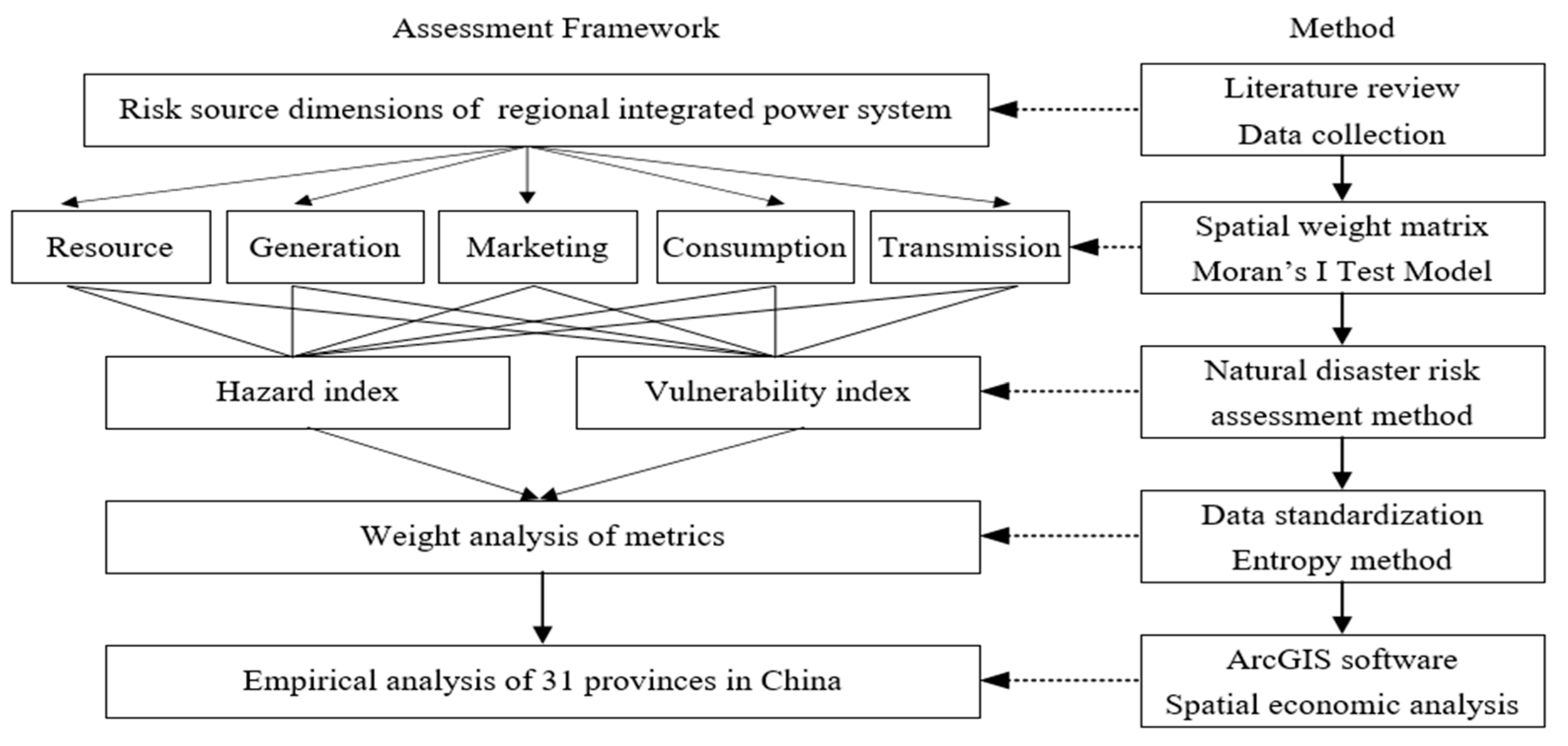
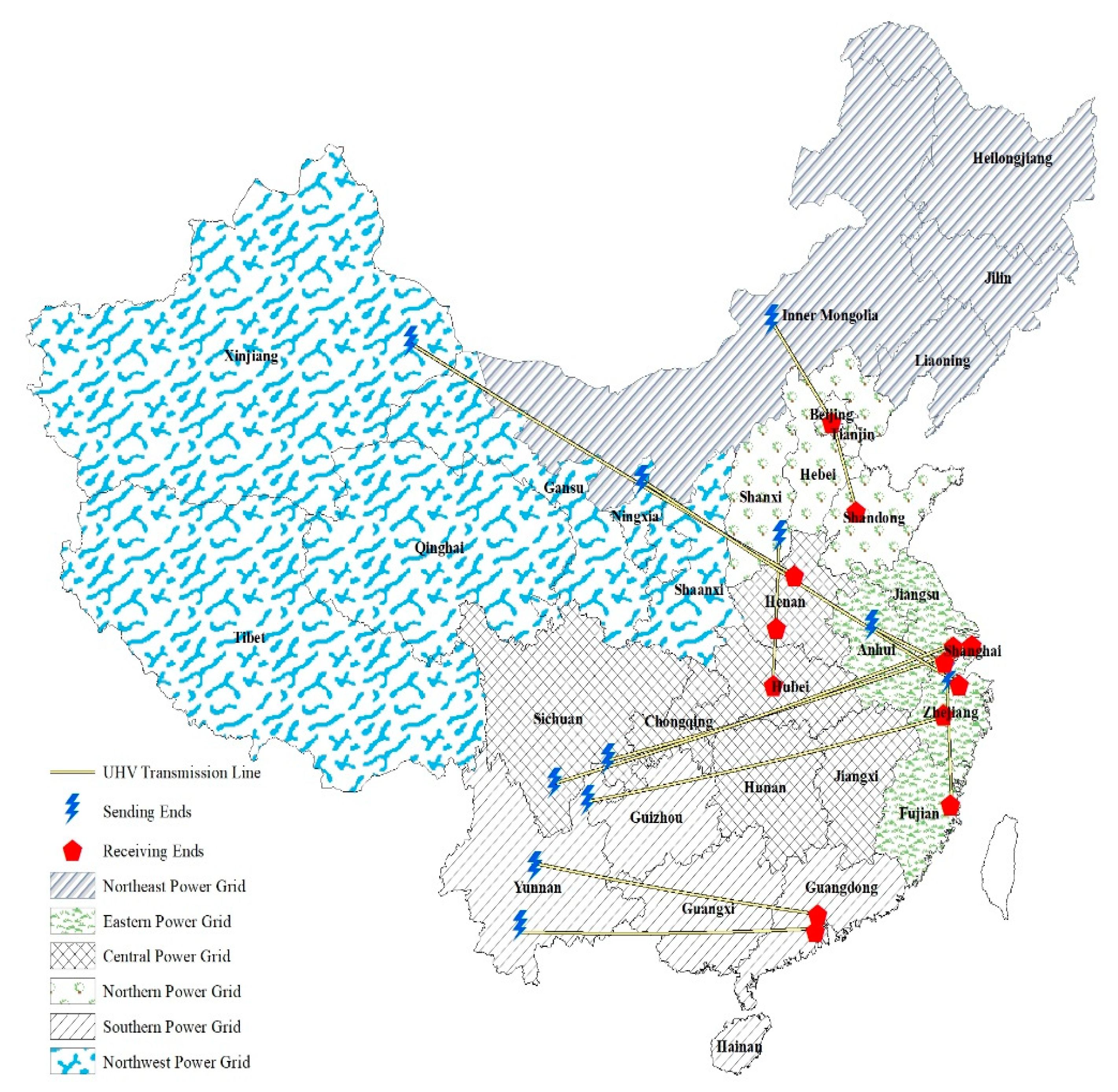
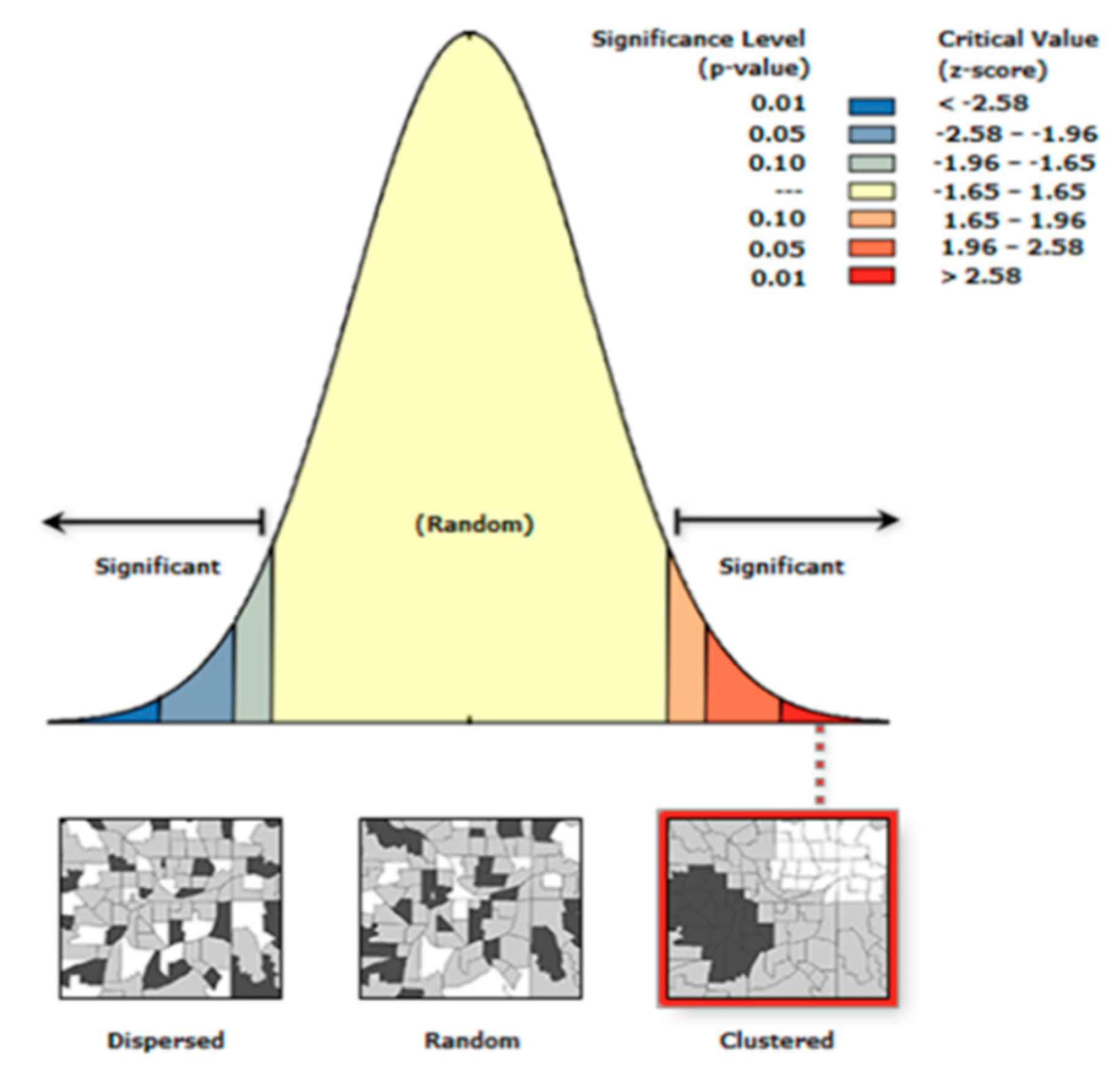

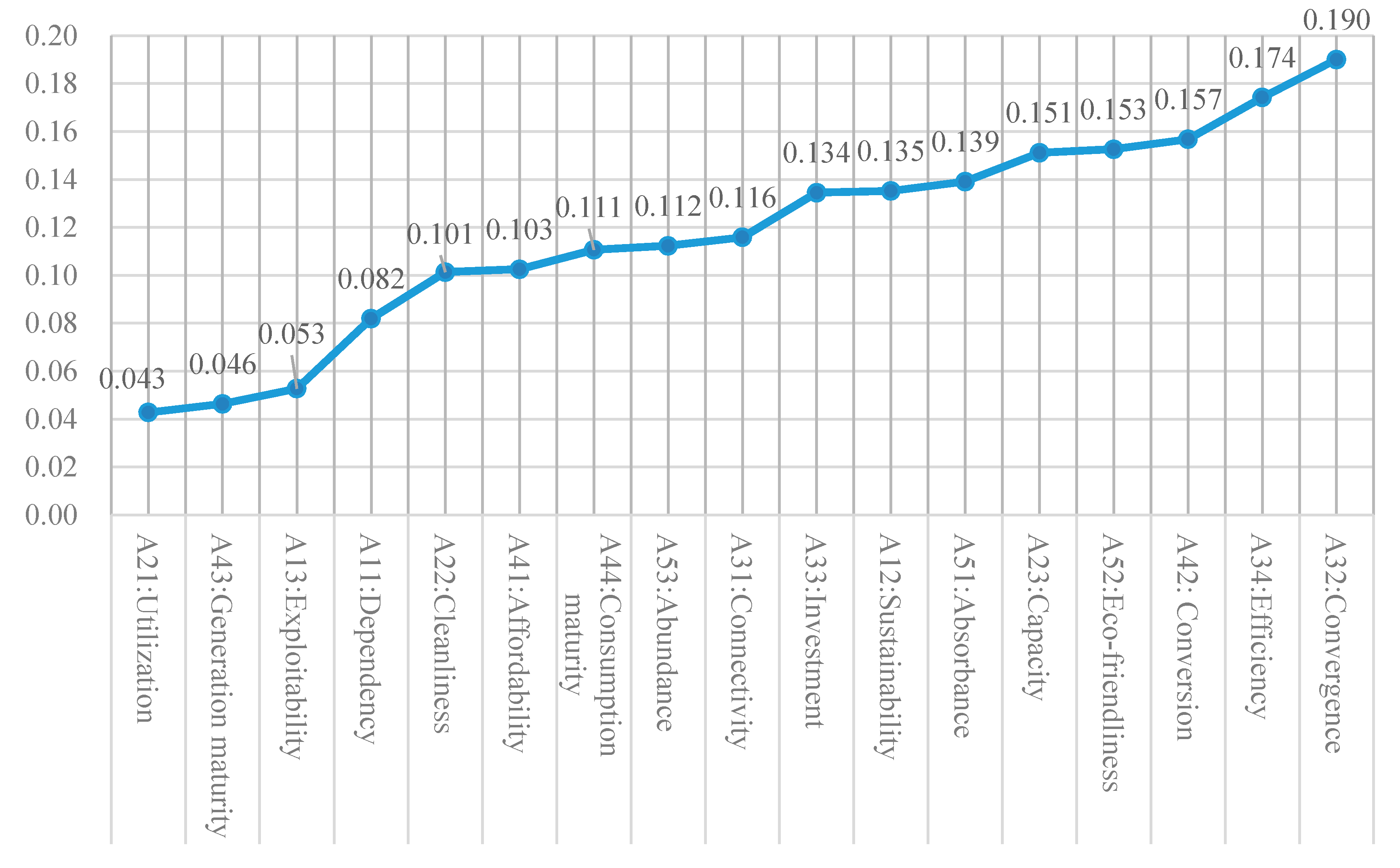
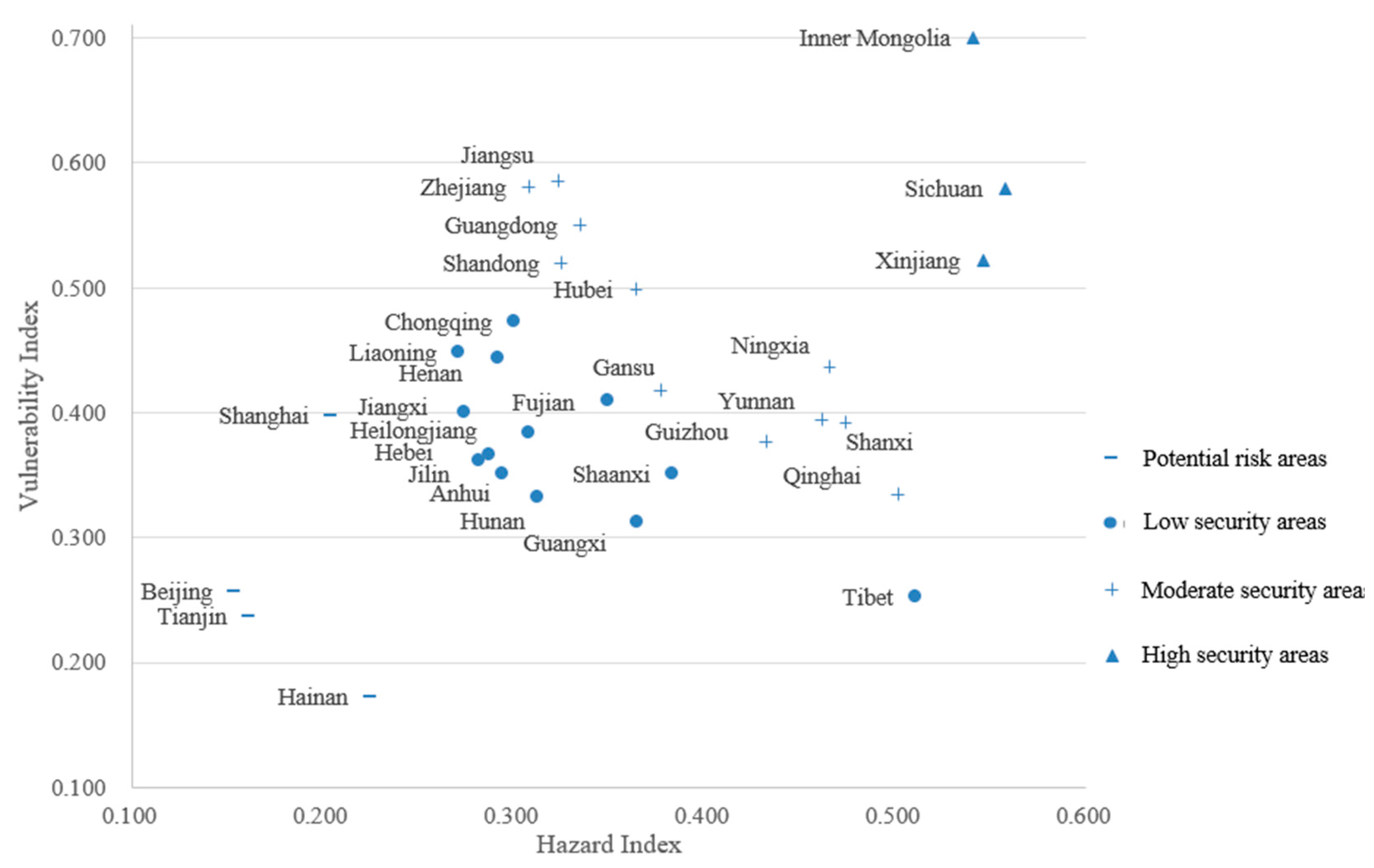
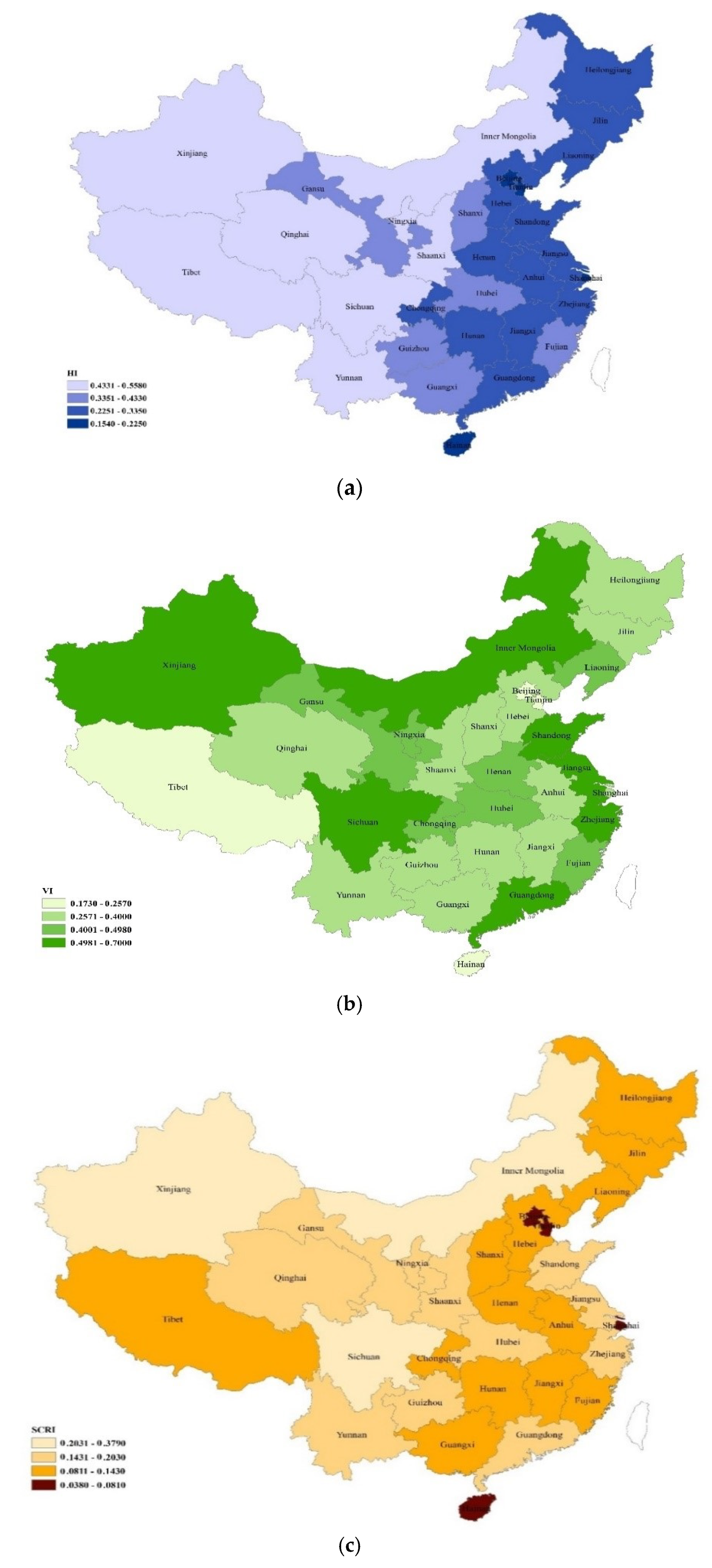
| Dimensions | Components | Metrics | Unit | Definition | Preference | References |
|---|---|---|---|---|---|---|
| A1: Resource | A11: Dependency | B11: Self sufficiency | % | =(Total primary energy production/total primary energy consumption)*100% | Greater preferred | [2,35,36,37,38] |
| A12: Sustainability | B12: Renewables technical exploitation amount | 107 W | Economic potentiality of hydroelectric, land 70m high wind resources and solar radiation | Greater preferred | [35,36,37,39,40] | |
| A13: Exploitability | B13: Installed capacity | 107 W | Total installed capacity of hydropower, thermal power, nuclear, wind, solar power, etc. | Greater preferred | [35,38,41] | |
| A2: Generation | A21: Utilization | B21: Utilization hours of installed capacity | Hours | Average utilization hours of all types of power generation equipment | Greater preferred | [2,35,39,40] |
| A22: Cleanliness | B22: Generation cleanliness | % | =(Non-thermal power generation/total generation)*100% | Greater preferred | [2,37,40,41,42] | |
| A23: Capacity | B23: Annual power generation | 108 kWh | Annual power generation, include hydropower, thermal power, nuclear, wind, solar power, etc. | Greater preferred | [36,41,43] | |
| A3: Transmission | A31: Connectivity | B31: Interprovincial line connections | - | The number of connections with other provinces in regional grid and through UHV transmission lines | Greater preferred | [35,37,38,39,41,42] |
| A32: Convergence | B32: Local spatial autocorrelation | - | Use local Moran’s I index to measure the degree of provincial association among associated area | Greater preferred | [35,42,44,45] | |
| A33: Investment | B33: Grid construction investment | 108 Yuan | Cumulative investment on grid construction | Greater preferred | [38,39,41,46] | |
| A34: Efficiency | B34: Electricity transmission losses | % | Between sources of supply and points of distribution and in the distribution to consumers | Smaller preferred | [35,36,39,40,43] | |
| A4: Marketing | A41: Affordability | B41: Power price | Yuan/MWh | =Total electricity sales revenue/total electricity consumption | Smaller preferred | [35,36,37,39,41,42] |
| A42: Conversion | B42: Electricity consumption per unit GDP | kWh/Yuan | =Annual electricity consumption/local gross domestic product | Greater preferred | [2,37,38,43] | |
| A43: Generation maturity | B43: Generation elasticity coefficient | - | =Annual growth rate of power generation/annual growth rate of local gross domestic product | Greater preferred | [35,43] | |
| A44: Consumption maturity | B44: Consumption elasticity coefficient | - | =Annual growth rate of power consumption/annual growth rate of local gross domestic product | Greater preferred | [35,43] | |
| A5: Consumption | A51: Absorbance | B51: Annual power consumption | 108 kWh | Comprises the consumption of hydropower, thermal power, nuclear, wind, solar power, etc. | Greater preferred | [2,36,37,41] |
| A52: Eco-friendliness | B52: Consumption cleanliness | % | =(Total renewable consumption/total electricity consumption)*100% | Greater preferred | [2,35,37,39,40,41] | |
| A53: Abundance | B53: Difference between supply and demand | 108 kWh | Provincial electricity generation minus electricity consumption | Greater preferred | [36,39,41] |
| Metrics | MAX | Province | MIN | Province | Mean | Standard Mean |
|---|---|---|---|---|---|---|
| Hazard Index (HI) | ||||||
| B11: Self sufficiency | 5.41 | Shanxi | 0.08 | Zhejiang | 1.05 | 0.18 |
| B21: Utilization hours of installed capacity | 4806 | Jiangsu | 2378 | Tibet | 3669.97 | 0.53 |
| B22: Generation cleanliness | 1.00 | Tibet | 0.02 | Tianjin | 0.29 | 0.28 |
| B41: Power price | 777.33 | Beijing | 360.54 | Jilin | 589.34 | 0.45 |
| B42: Electricity consumption per unit GDP | 0.28 | Ningxia | 0.04 | Beijing | 0.93 | 0.22 |
| B44: Consumption elasticity coefficient | 2.07 | Xinjiang | −0.51 | Gansu | 0.63 | 0.44 |
| B51: Annual power consumption | 5610 | Guangdong | 49 | Tibet | 1927.39 | 0.34 |
| B52: Consumption cleanliness | 0.85 | Tibet | 0.06 | Shandong | 0.31 | 0.31 |
| B53: Difference between supply and demand | 1345 | Inner Mongolia | −1574 | Guangdong | 15.54 | 0.55 |
| Vulnerability index (VI) | ||||||
| B12: Renewable technical exploitation amount | 146,713 | Inner Mongolia | 74 | Shanghai | 9683.26 | 0.07 |
| B13: Installed capacity | 11,044 | Inner Mongolia | 233 | Tibet | 5308.81 | 0.47 |
| B23: Annual power generation | 4863 | Shandong | 51 | Tibet | 1942.93 | 0.39 |
| B31: Interprovincial line connections | 7 | Henan | 3 | Hei/Ji/Liao | 4.77 | 0.44 |
| B32: Local spatial autocorrelation | 1.78 | Hei/Ji/Liao | −0.25 | Hainan | 0.71 | 0.31 |
| B33: Grid construction investment | 838.43 | Zhejiang | 38.55 | Hainan | 283.23 | 0.31 |
| B34: Electricity transmission losses | 13.83 | Qinghai | 3.35 | Tibet | 6.48 | 0.70 |
| B43: Generation elasticity coefficient | 2.81 | Tibet | −0.54 | Qinghai | 0.66 | 0.36 |
| Regional Power Grid | Provinces | Number |
|---|---|---|
| Northeast power grid | Heilongjiang, Jilin, Liaoning, Inner Mongolia | 4 |
| Eastern power grid | Jiangsu, Anhui, Shanghai, Zhejiang, Fujian | 5 |
| Central power grid | Henan, Hubei, Sichuan, Chongqing, Hunan, Jiangxi | 6 |
| Northern power grid | Beijing, Hebei, Tianjin, Shanxi, Shandong | 5 |
| Southern power grid | Yunnan, Guizhou, Guangxi, Guangdong, Hainan | 5 |
| Northwest power grid | Xinjiang, Tibet, Qinghai, Gansu, Ningxia, Shaanxi | 6 |
| Type | NO. | Line Route | Annual Capacity (TWh) |
|---|---|---|---|
| AC-UHV | 1 | Shanxi-Henan-Hubei | 82.5 |
| 2 | Inner Mongolia-Beijing-Shandong | 32.8 | |
| 3 | Anhui-Zhejiang-Jiangsu-Shanghai | 202.9 | |
| 4 | Zhejiang-Fujian | 17.1 | |
| DC-UHV | 5 | Sichuan-Shanghai | 326.1 |
| 6 | Sichuan-Jiangsu | 383.3 | |
| 7 | Yunnan-Zhejiang | 367.5 | |
| 8 | Xinjiang-Henan | 322.6 | |
| 9 | Ningxia-Zhejiang | 72.8 | |
| 10 | Yunnan Chuxiong-Guangdong Guangzhou | 261.8 | |
| 11 | Yunnan Puer-Guangdong Jiangmen | 264.5 | |
| Total | 2333.9 | ||
| Attribute | Moran’s I | Z Score | p Value |
|---|---|---|---|
| Renewable electricity consumption amount | 0.165972 | 1.987872 | 0.046826 * |
| Non-hydro renewable electricity consumption amount | 0.186680 | 2.088084 | 0.036790 * |
| Non-hydro renewable electricity consumption ratio | 0.455189 | 4.508009 | 0.000007 ** |
Publisher’s Note: MDPI stays neutral with regard to jurisdictional claims in published maps and institutional affiliations. |
© 2020 by the authors. Licensee MDPI, Basel, Switzerland. This article is an open access article distributed under the terms and conditions of the Creative Commons Attribution (CC BY) license (http://creativecommons.org/licenses/by/4.0/).
Share and Cite
Zhao, Z.; Yang, H. Regional Security Assessment of Integrated Energy Systems with Renewables in China: A Grid-Connected Perspective. Sustainability 2020, 12, 10299. https://doi.org/10.3390/su122410299
Zhao Z, Yang H. Regional Security Assessment of Integrated Energy Systems with Renewables in China: A Grid-Connected Perspective. Sustainability. 2020; 12(24):10299. https://doi.org/10.3390/su122410299
Chicago/Turabian StyleZhao, Zhenyu, and Huijia Yang. 2020. "Regional Security Assessment of Integrated Energy Systems with Renewables in China: A Grid-Connected Perspective" Sustainability 12, no. 24: 10299. https://doi.org/10.3390/su122410299
APA StyleZhao, Z., & Yang, H. (2020). Regional Security Assessment of Integrated Energy Systems with Renewables in China: A Grid-Connected Perspective. Sustainability, 12(24), 10299. https://doi.org/10.3390/su122410299




